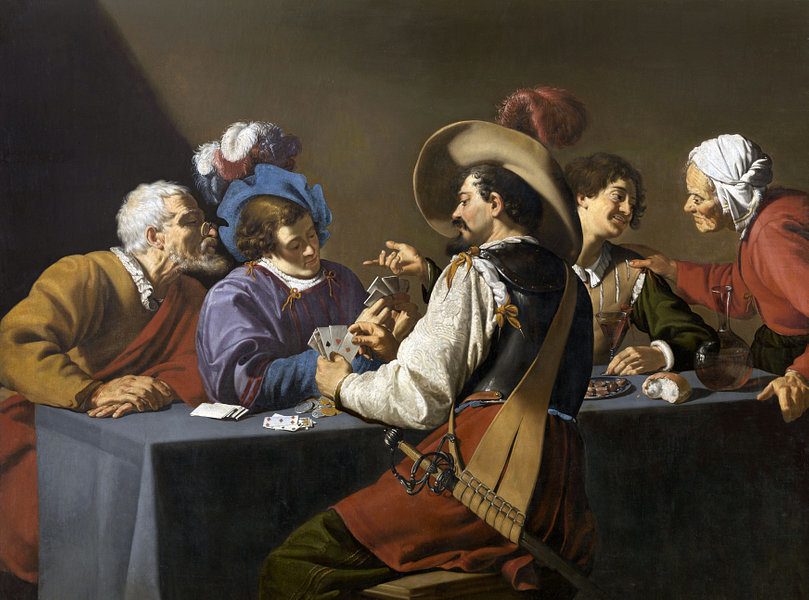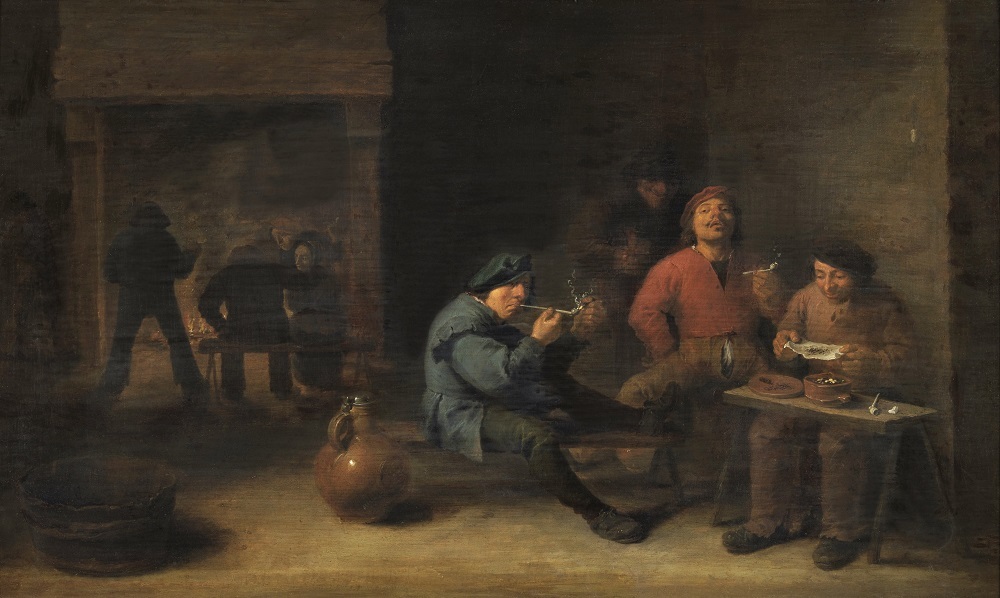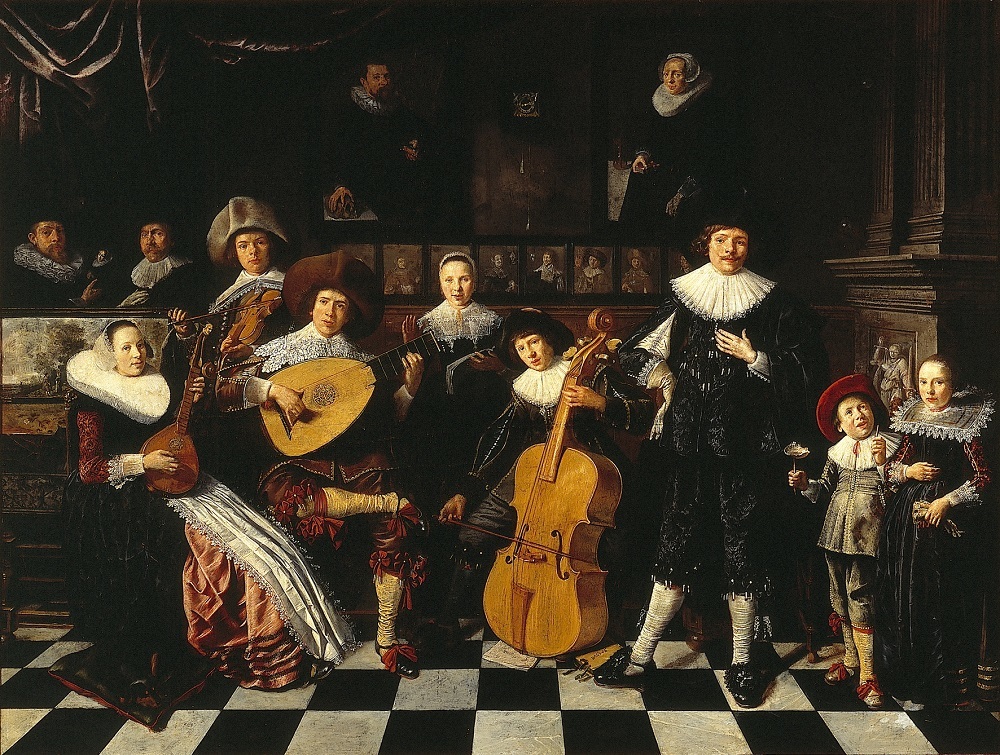SOLD
Square tin drum with a gold-coloured knob with an image of paintings by Dutch masters
SKU: BT-3613-21Square tin drum with a gold-coloured knob with an image of paintings by Dutch masters
- Manufacturer: Verblifa / container made in Holland
- Date of manufacture: 1935 - 1939
Square tin with gold-coloured knob depicting paintings by Dutch masters, entirely factory-made with relief and colour.
Description
Vintage tin with a square shape, equipped with a double-walled overhanging impression lid with rolled edges. On top of the lid is a gold-coloured knob with decorations all around. The tin stands on four legs which are punched out in the bottom. Longitudinal seam on one of the corners.
The decoration of this tin consists of a gold-coloured background with ornaments in relief. Decorated frames on all four sides with reproductions of paintings by Theodoor Rombouts, David Teniers, Adriaen Brouwer, Jan Miense Molenaer.
Made for the English market. Manufactured by Verlifa. Marked on the bottom: Container made in Holland
Condition
This tin is in an original vintage condition with traces of use and age-related traces of wear. Photos are part of the description.
Size
- Height: 18 cm. (incl. button)
- Length: 14 cm.
- Width: 14 cm.

Theodoor Rombouts (1597 – 1637) was a Flemish painter who is mainly known for his Caravaggesque genre scenes depicting lively dramatic gatherings as well as religiously themed works. He is considered to be the primary and most original representative of Flemish Caravaggism. These Caravaggisti were part of an international movement of European artists who interpreted the work of Caravaggio and the followers of Caravaggio in a personal manner.
David Teniers the Elder (1582 – 1649), Flemish painter, was born at Antwerp.
Having received his first training in the painter's art from his brother Juliaen, he studied under Rubens in Antwerp, and subsequently under Elsheimer in Rome; he became a member of the Antwerp guild of painters in 1606.
Though his ambition led him at times to try his skill in large religious, historical and mythological compositions, his claim to fame depends chiefly on his landscapes and paintings of peasants carousing, of kermesse scenes and the like, which are marked by a healthy sense of humour, and which are not infrequently confused with the early works of his son David.

Adriaen Brouwer (1605 - 1638) was a Flemish painter active in Flanders and the Dutch Republic in the first half of the 17th century. Brouwer was an important innovator of genre painting through his vivid depictions of peasants, soldiers and other "lower class" individuals engaged in drinking, smoking, card or dice playing, fighting, music making etc. in taverns or rural settings. Brouwer contributed to the development of the genre of tronies, i.e. head or facial studies, which investigate varieties of expression. In his final year he produced a few landscapes of a tragic intensity. Brouwer's work had an important influence on the next generation of Flemish and Dutch genre painters.

Jan Miense Molenaer (1610 – 1668), was a Dutch Golden Age genre painter whose style was a precursor to Jan Steen's work during Dutch Golden Age painting. He shared a studio with his wife, Judith Leyster, also a genre painter, as well as a portraitist and painter of still-life. Both Molenaer and Leyster may have been pupils of Frans Hals.
Molenaer was born and died in Haarlem. He achieved a style close to Hals' early on in his career, but later developed a style like that of Dutch genre painter, Adriaen van Ostade. His genre works often depicted players of music, such as his The Music Makers (Museum of Fine Arts, Budapest), The Duet (Seattle Art Museum), or Family Making Music (Frans Hals Museum). He also depicted Taverns and the activities of card games or games of the times such as La main chaude, or in Dutch, Handjeklap, which literally means clapping hands. Molenaer also cleverly depicted biblical stories in his own time and surroundings, such as representing a scene from Peter's Gospel set in a Dutch Tavern in The Denying of Peter (Museum of Fine Arts, Budapest).
Some translations come from an automated system and may contain errors.
Country of origin
The Netherlands - Holland
Kind of object
Vintage tin
Theme
Tin - storage - knob - relief - paintings - old masters
Decoration
Reproductions of Old Master paintings
Category
Vintage tins
Color
Goldcoloured - multicoloured
Publisher
Container made in Holland
Manufacturer
Verblifa (vereenigde blik fabrikanten)
Material
Tin - metal - paint
Particularities
Double-walled overhanging press-in lid with button
Era
1935 - 1939
Quality
Vintage with traces of use, wear and tear
Height
18,00 cm (incl. knop)
Lenght
14,00 cm
Width
14,00 cm
Shipping method
Parcel post with track & trace





























